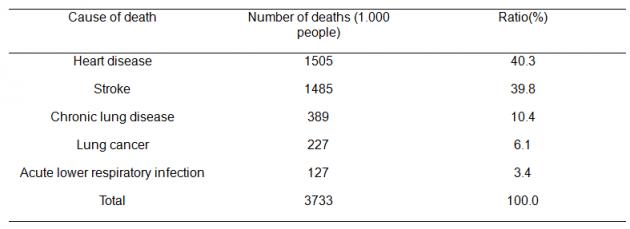Recent research says fine dust is more likely to lead to heart problem and stroke rather than lung disease, adding that nearly 50 percent of fine dust-related deaths result from stroke.
The findings by the research team led by Professor Hong Yoon-chul from Seoul National University College of Medicine, Department of Preventive Medicine, will be published in the July edition of Korean Academy of Medical Sciences’ international journal JKMS.
The study found around 11,900 Koreans died prematurely from fine dust. Out of the 11,900, 5,646 died from the stroke, 3,303 from cardiovascular disease, and 2,338 from lung cancer.
The results matched the reports from the World Health Organization that showed out of total fine dust-related deaths, around 40 percent were attributable to heart disease and 40 percent to stroke, making the two conditions account for 80 percent of all deaths. Deaths from respiratory disease stood at around 20 percent.

Fine dust and ultrafine dust (smaller than 2.5 μm) are not filtered by the bronchial cilia and is absorbed into our body through the alveolar capillary. As the fine dust circulates throughout the bloodstream, it gives rise to more infectious reactions, worsens atherosclerosis, damages vascular cell function, and causes arrhythmia through autonomic dysfunction and triggers stroke,” Chairman Na Jung-ho of the Korean Stroke Society said.
“Contrary to general perception, the fine dust has a bigger impact of vascular diseases such as stroke rather than respiratory disease,” he added
According to a survey conducted by a research team led by Professor Lee Mi-young from Soonchunhyang Medical Science, more than 90 percent said that environmental pollutants such as fine dust was related to lung disease. Less than 5 percent said that it is associated with neurological disease such as stroke.
“Environmental pollutants such as fine dust affect not only respiratory diseases but also metabolic diseases such as diabetes and obesity and especially neurological diseases such as stroke, dementia and Parkinson’s,” Professor Lee said.
Fine dust is a small substance that is invisible to the naked eye with a diameter of less than 10μm (about 1/30 of a hair). Deaths caused by fine dust are increasing worldwide with reports showing the mortality rate being four to 10 times higher in East Asia than in Europe and the United States.

